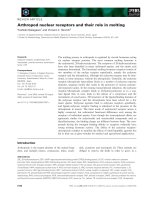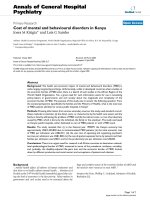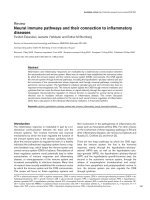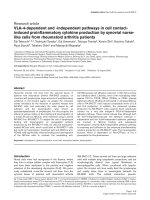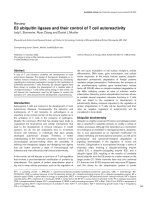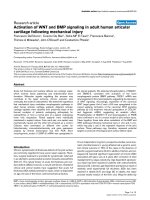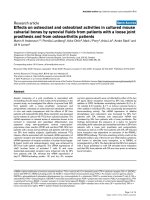Báo cáo y học: " Oxygen-regulated transcription factors and their role in pulmonary disease" pptx
Bạn đang xem bản rút gọn của tài liệu. Xem và tải ngay bản đầy đủ của tài liệu tại đây (209.34 KB, 4 trang )
commentary
review
reports primary research
Review
Oxygen-regulated transcription factors and their role in
pulmonary disease
Gregg L Semenza
Johns Hopkins University School of Medicine, Baltimore, Maryland, USA
Abstract
The transcription factors nuclear factor interleukin-6 (NF-IL6), early growth response-1
(EGR-1) and hypoxia-inducible factor-1 (HIF-1) have important roles in the molecular
pathophysiology of hypoxia-associated pulmonary disease. NF-IL6 controls the production of
interleukin (IL)-6 in vascular endothelial cells, which may have anti-inflammatory activity by
counteracting effects of IL-1 and IL-8. EGR-1 controls the production of tissue factor by
macrophages, which triggers fibrin deposition in the pulmonary vasculature. HIF-1 activates
the expression of the vasoconstrictor endothelin-1 in vascular endothelial cells. Angiotensin II
induces HIF-1 expression and hypertrophy of pulmonary arterial smooth muscle cells. HIF-1
might therefore have multiple roles in the pathogenesis of pulmonary vascular remodeling.
Keywords: EGR-1, HIF-1, NF-IL6, vascular remodeling
Received: 27 September 2000
Revisions requested: 10 October 2000
Revisions received: 16 October 2000
Accepted: 19 October 2000
Published: 9 November 2000
Respir Res 2000, 1:159–162
The electronic version of this article can be found online at
/>© Current Science Ltd (Print ISSN 1465-9921; Online ISSN 1465-993X)
AP-1 = activator protein-1; ECs = endothelial cells; EGR-1 = early growth response-1; ET-1 = endothelin-1; HIF-1 = hypoxia-inducible factor-1;
HMG = high-mobility group; IL = interleukin; NF-IL6 = nuclear factor interleukin-6; PAS = Per/ARNT/Sim; SMC = smooth muscle cell; VEGF =
vascular endothelial growth factor.
/>Introduction
Chronic lung disease is a major cause of morbidity and
mortality in western populations. It is the fourth leading
cause of death in the USA, accounting for 5% of all
deaths annually. Although many patients with chronic
obstructive lung disease die from infections, the develop-
ment of alveolar hypoxia is a complication that is also
associated with increased mortality. Recent studies have
begun to delineate the molecular responses to hypoxia
within the lung and its vasculature. An understanding of
the molecular pathophysiology of hypoxia-associated pul-
monary disease might lead to strategies for the prevention
and/or treatment of life-threatening complications. The
pathophysiology of chronic diseases must ultimately be
understood in terms of changes in gene expression that
are mediated by transcription factors. The transcription of
several dozen target genes is known to be induced in
hypoxic cells (Table 1). Similarly, the activities of several
transcription factors are induced in mammalian cells sub-
jected to hypoxia, including activator protein-1 (AP-1),
early growth response-1 (EGR-1), hypoxia-inducible
factor-1 (HIF-1), high-mobility group (HMG) I(Y), nuclear
factor interleukin-6 (NF-IL6), and NF-κB, although the
mechanisms by which hypoxia is sensed and the signal is
transduced remain enigmatic [1]. This review focuses on
the transcription factors EGR-1, HIF-1, and NF-IL6, which
are important in the pathophysiology of hypoxic lung
disease.
Respiratory Research Vol 1 No 3 Semenza
NF-IL6
NF-IL6 (also known as C/EBPβ, for CCAAT-enhancer-
binding protein-β) is a basic-leucine-zipper transcription
factor that activates IL-6 gene transcription in hypoxic pul-
monary vascular endothelial cells (ECs) [2]. The NF-IL6-
binding site from the IL-6 promoter was sufficient to direct
the expression of a lacZ gene in the heart, kidney, and lung,
but not the liver, of transgenic mice subjected to hypoxia or
ischemia [3]. The basis for the tissue-specific induction of
NF-IL6 expression in vascular ECs is not known. Because
IL-6 is a cytokine with anti-inflammatory properties, it might
counteract the effects of proinflammatory cytokines. For
example, the expression of IL-1 and IL-8 are also induced in
hypoxic ECs [4,5] and promote the expression of adher-
ence molecules that recruit activated leukocytes to the
vessel wall, leading to vascular leakage and/or thrombus
formation [6
•
]. Thus, NF-IL6 might protect the integrity of
the pulmonary vasculature under conditions of hypoxia or
ischemia.
EGR-1
EGR-1 (also known as ZIF268) is a zinc-finger transcrip-
tion factor that is expressed in hypoxic mononuclear
phagocytes [7]. EGR-1-mediated production of tissue
factor by monocytes leads to hypoxia-induced fibrin depo-
sition in the pulmonary vasculature [8]. In the lungs of mice
subjected to hypoxia, EGR-1 and tissue factor are co-
induced in bronchial and vascular smooth muscle and alve-
olar macrophages [9]. When wild-type mice are exposed to
an ambient O
2
concentration of 6% (reduced from the
21% O
2
in room air), EGR-1 and tissue factor expression
are induced in the lung and marked vascular deposition of
fibrin is observed, whereas none of these responses occur
in knockout mice lacking expression of the gene encoding
protein kinase C-β [10
••
]. The mechanism by which hypoxia
activates protein kinase C-β activity in mononuclear phago-
cytes is unknown but this activity seems to be crucial for
the induction of EGR-1 activity and tissue factor produc-
tion. EGR-1 also mediates tissue factor production by
endothelial cells in response to stimulation by vascular
endothelial growth factor (VEGF) [11], the hypoxia-induced
expression of which is mediated by HIF-1 (see below), indi-
cating that hypoxia induces tissue factor expression by two
different mechanisms that both involve EGR-1. Thus, in
contrast to NF-IL6, hypoxia-induced EGR-1 activity pro-
motes pulmonary vascular thrombosis.
HIF-1
Hypoxia-inducible factor-1 (HIF-1) is a heterodimeric basic
helix–loop–helix–Per/ARNT/Sim (PAS)-domain trans-
cription factor composed of HIF-1α and HIF-1β subunits
[12]. In contrast to NF-IL6 and EGR-1, HIF-1 is expressed
in most, if not all, nucleated mammalian cells in response
to hypoxia; several dozen target genes have been identi-
fied, including VEGF (Table 1). HIF-1β is expressed con-
stitutively, whereas HIF-1α expression in the lung is
Table 1
Hypoxia-inducible gene expression
Gene product Transcription factor*
Adenylate kinase 3 HIF-1
α
1B
-Adrenergic receptor HIF-1
Adrenomedullin HIF-1
Aldolase A HIF-1
Aldolase C HIF-1
Carbonic anhydrase-9 HIF-1
Ceruloplasmin HIF-1
Cyclooxygenase-2 HMG I(Y), NF-κB
Endothelin-1 HIF-1
Enolase-1 HIF-1
Erythropoietin HIF-1
GADD153 Not determined
Glucose transporter-1 HIF-1
Glucose transporter-3 HIF-1
Glyceraldehyde-3-phosphate HIF-1
dehydrogenase
Heme oxygenase-1 AP-1, HIF-1
Hexokinase-1 HIF-1
Hexokinase-2 HIF-1
Insulin-like growth factor-2 (IGF-2) HIF-1
IGF-binding protein-1 HIF-1
IGF-binding protein-2 HIF-1
IGF-binding protein-3 HIF-1
Interleukin-6 NF-IL6
Lactate dehydrogenase A HIF-1
Nitric oxide synthase-2 HIF-1
NIP3 HIF-1
Ornithine decarboxylase Not determined
p21 HIF-1
p27 Not determined
p35srj HIF-1
Phosphofructokinase L HIF-1
Phosphoglycerate kinase-1 HIF-1
Plasminogen activator inhibitor-1 HIF-1
Prolyl-4-hydroxylase α(I) HIF-1
Pyruvate kinase M HIF-1
Tissue factor EGR-1
Transferrin HIF-1
Transferrin receptor HIF-1
Transforming growth factor β
3
HIF-1
Triosephosphate isomerase HIF-1
Tyrosine hydroxylase AP-1
Vascular endothelial growth factor (VEGF) HIF-1
VEGF receptor FLT-1 HIF-1
*See [12] for literature citations.
commentary
review
reports primary research
/>regulated by the inspired O
2
concentration [13] (Fig. 1).
Homozygous-null knockout mice that completely lack
HIF-1α expression die at mid-gestation owing to the failure
of embryonic vascularization [14–16]. Mice heterozygous
for the null allele (Hif1a
+/–
), and thus partly deficient for
HIF-1α expression, develop normally and are indistinguish-
able from their wild-type littermates under normoxic condi-
tions. Wild-type mice exposed to 10% O
2
develop
pulmonary hypertension in response to chronic hypoxia.
Medial wall thickening in pulmonary arterioles results in
increased pulmonary arterial pressure and right ventricular
hypertrophy. The remodeling is progressive and if contin-
ued leads to cor pulmonale. In Hif1a
+/–
mice, the hypoxia-
induced muscularization of pulmonary arterioles is
significantly impaired, resulting in significantly less medial
wall thickening, pulmonary artery hypertension, and right
ventricular hypertrophy after 3 weeks at 10% O
2
[17
••
].
Although the pathophysiology of pulmonary hypertension is
complex [18], a major component of this process is the
elaboration of peptides, such as endothelin-1 (ET-1) and
angiotensin II, that induce smooth muscle cell (SMC) con-
traction and hypertrophy. ET-1 expression is induced within
the pulmonary vasculature of hypoxic rats [19], and ET
A
-
receptor antagonists prevent/reverse chronic hypoxia-
induced pulmonary hypertension [20]. A HIF-1-binding site
in the ET-1 gene promoter is required for hypoxia-induced
transcription [21
•
], suggesting that ET-1 mRNA expression
by hypoxic pulmonary vascular ECs is mediated by HIF-1.
Expression of angiotensin-converting enzyme (ACE),
which converts angiotensin I to angiotensin II, is also
induced within the pulmonary vasculature of hypoxic rats
[22]. The administration of captopril, an ACE inhibitor, or
losartan, a type 1 angiotensin receptor antagonist, also
attenuates the development of hypoxic pulmonary hyper-
tension [23]. Angiotensin II, which induces vascular SMC
hypertrophy, has recently been shown to induce HIF-1α
expression [24
••
]. These results suggest that HIF-1 might
be required for the angiotensin-induced hypertrophy of
vascular SMCs in the hypoxic lung.
In addition to SMC hypertrophy, hypoxia is associated
with increased pulmonary vascular tone, which also
reduces luminal diameter. One determinant of vascular
tone is the production by ECs of ET-1, a potent SMC
vasoconstrictor. The activity of voltage-gated potassium
(K
V
) channels is another important determinant of SMC
membrane potential and pulmonary vasomotor tone. Acute
hypoxia inhibits K
V
channel activity, resulting in the depo-
larization and vasoconstriction of pulmonary artery SMCs.
Chronic hypoxia is associated with downregulation of
K
V
1.2 and K
V
1.5mRNA expression [25], but the involve-
ment of HIF-1 or another hypoxia-induced transcription
factor in this process has not yet been demonstrated.
Conclusion
NF-IL6, EGR-1, and HIF-1 mediate important physiological
responses to chronic hypoxia in macrophages and pul-
monary vascular ECs and SMCs. NF-IL6 might mediate
adaptive anti-inflammatory responses, but definitive
studies with knockout mice have not been performed. In
contrast, analysis of Egr1
–/–
and Hif1a
+/–
mice has pro-
vided definitive evidence that EGR-1 and HIF-1 mediate
pathophysiologic responses to chronic hypoxia, suggest-
ing that pharmacologic inhibition of these factors might be
Figure 1
HIF-1-mediated gene expression in response to hypoxia. Under non-hypoxic conditions, the HIF-1α subunit is subject to ubiquitination and
degradation, whereas under hypoxic conditions HIF-1α ubiquitination is inhibited, resulting in the accumulation of HIF-1α, which dimerizes with
HIF-1β. The heterodimer recognizes the core binding-site sequence 5′-RCGTG-3′ (R, purine) found within the hypoxia response element of a
target gene. Once bound, HIF-1 interacts with the transcription initiation complex (consisting of RNA polymerase II and associated factors) via
coactivators including CBP, P300, SRC-1, and TIF-2 (see [12] for details and literature citations).
useful in the prevention or treatment of hypoxia-induced
pulmonary vascular pathology.
Acknowledgements
Work in the author’s laboratory is supported by grants from the National
Institutes of Health (R01-DK39869 and R01-HL55338).
References
Articles of particular interest have been highlighted as:
•
of special interest
••
of outstanding interest
1. Semenza GL: Perspectives on oxygen sensing. Cell 1999, 98:
281–284.
2. Yan SF, Tritto I, Pinsky D, Liao H, Huang J, Fuller G, Brett J, May L,
Stern D: Induction of interleukin 6 (IL-6) by hypoxia in vascular
cells: central role of the binding site for nuclear factor-IL6. J Biol
Chem 1995, 270:11463–11471.
3. Yan SF, Zou YS, Mendelsohn M, Gao Y, Naka Y, Du Yan S, Pinsky D,
Stern D: Nuclear factor interleukin 6 motifs mediate tissue-spe-
cific gene transcription in hypoxia. J Biol Chem 1997, 272:
4287–4294.
4. Karakurum M, Shreeniwas R, Chen J, Pinsky D, Yan SD, Anderson M,
Sunouchi K, Major J, Hamilton T, Kuwabara K, et al: Hypoxic induc-
tion of interleukin-8 gene expression in human endothelial cells. J
Clin Invest 1994, 93:1564–1570.
5. Shreeniwas R, Koga S, Karakurum M, Pinsky D, Kaiser E, Brett J,
Wolitzky BA, Norton C, Plocinski J, Benjamin W, et al: Hypoxia-medi-
ated induction of endothelial cell interleukin-1a: an autocrine
mechanism promoting expression of leukocyte adhesion mole-
cules on the vessel surface. J Clin Invest 1992, 90:2333–2339.
6. Michiels C, Arnould T, Remacle J: Endothelial cell responses to
•
hypoxia: initiation of a cascade of cellular interactions. Biochim
Biophys Acta 2000, 1497:1–10.
An excellent review of EC–leukocyte interactions involved in vascular inflam-
matory responses to hypoxia.
7. Yan SF, Zou YS, Gao Y, Zhai C, Mackman N, Lee SL, Milbrandt J,
Pinsky D, Kisiel W, Stern D: Tissue factor transcription driven by
Egr-1 is a critical mechanism of murine pulmonary fibrin deposi-
tion in hypoxia. Proc Natl Acad Sci USA 1998, 95:8298–8303.
8. Lawson CA, Yan SD, Yan SF, Liao H, Zhou YS, Sobel J, Kisiel W,
Stern DM, Pinsky DJ: Monocytes and tissue factor promote throm-
bosis in a murine model of oxygen deprivation. J Clin Invest 1997,
99:1729–1738.
9. Yan SF, Lu J, Xu L, Zou YS, Tongers J, Kisiel W, Mackman N, Pinsky
DJ, Stern DM: Pulmonary expression of early growth response-1:
biphasic time course and effect of oxygen concentration. J Appl
Physiol 2000, 88:2303–2309.
10. Yan SF, Lu J, Zou YS, Kisiel W, Mackman N, Leitges M, Steinberg S,
••
Pinsky D, Stern D: Protein kinase C-
ββ
and oxygen deprivation: a
novel Egr-1-dependent pathway for fibrin deposition in hypoxemic
vasculature. J Biol Chem 2000, 275:11921–11928.
Using knockout mice, the authors demonstrate that fibrin deposition sec-
ondary to tissue factor production in the lungs of hypoxic mice requires
PKC-β-dependent induction of EGR-1 activity.
11. Mechtcheriakova D, Wlachos A, Holzmuller H, Binder BR, Hofer E:
Vascular endothelial cell growth factor-induced tissue factor
expression in endothelial cells is mediated by EGR-1. Blood 1999,
93:3811–3823.
12. Semenza GL: HIF-1: mediator of physiological and pathophysio-
logical responses to hypoxia. J Appl Physiol 2000, 88:1474–1480.
13. Yu AY, Frid MG, Shimoda LA, Wiener CM, Stenmark K, Semenza GL:
Temporal, spatial, and oxygen-regulated expression of hypoxia-
inducible factor 1 in the lung. Am J Physiol 1998, 275:L818–L826.
14. Iyer NV, Kotch LE, Agani F, Leung SW, Laughner E, Wenger RH,
Gassmann M, Gearhart JD, Lawler AM, Yu AY, Semenza GL: Cellular
and developmental control of O
2
homeostasis by hypoxia-
inducible factor 1
αα
. Genes Dev 1998, 12:149–162.
15. Kotch LE, Iyer NV, Laughner E, Semenza GL: Defective vasculariza-
tion of HIF-1
αα
-null embryos is not associated with VEGF defi-
ciency but with mesenchymal cell death. Dev Biol 1999, 209:
254–267.
16. Ryan HE, Lo J, Johnson RS: HIF-1
αα
is required for solid tumor for-
mation and embryonic vascularization. EMBO J 1998, 17:
3005–3015.
17. Yu AY, Shimoda LA, Iyer NV, Huso DL, Sun X, McWilliams R, Beaty T,
••
Sham JS, Wiener CM, Sylvester JT, Semenza GL: Impaired physio-
logical responses to chronic hypoxia in mice partially deficient for
hypoxia-inducible factor 1
αα
. J Clin Invest 1999, 103:691–696.
In comparison with wild-type littermates, the muscularization of pulmonary
arterioles is significantly decreased in heterozygous HIF-1α-null mice
exposed to hypoxia for 3 weeks, indicating that partial HIF-1α deficiency is
sufficient to impair hypoxia-induced pulmonary vascular remodeling.
18. Stenmark KR, Mecham RP: Cellular and molecular mechanisms of
pulmonary vascular remodeling. Annu Rev Physiol 1997, 59:
89–144.
19. Li H, Chen SJ, Chen YF, Meng QC, Durand J, Oparil S, Elton TS:
Enhanced endothelin-1 and endothelin receptor gene expression
in chronic hypoxia. J Appl Physiol 1994, 77:1451–1459.
20. DiCarlo VS, Chen SJ, Meng QC, Durand J, Yano M, Chen YF, Oparil
S: ETA-receptor antagonist prevents and reverses chronic
hypoxia-induced pulmonary hypertension in rat. Am J Physiol
1995, 269:L690–L697.
21. Hu J, Discher DJ, Bishopric NH, Webster KA: Hypoxia regulates
•
expression of the endothelin-1 gene through a proximal hypoxia-
inducible factor-1 binding site on the antisense strand. Biochem
Biophys Res Commun 1998, 245:894–899.
The authors demonstrate the presence of a HIF-1-binding site,
5′-ACGTGC-3′, located 118–125 bp 5′ to the transcription start site, that
is required for hypoxia-induced ET-1 gene expression in cardiac myocytes.
22. Morrell NW, Atochina EN, Morris KG, Danilov SG, Stenmark KR:
Angiotensin converting enzyme expression is increased in small
pulmonary arteries of rats with hypoxia-induced pulmonary hyper-
tension. J Clin Invest 1995, 96:1823–1833.
23. Morrell NW, Morris KG, Stenmark KR: Role of angiotensin-convert-
ing enzyme and angiotensin II in development of hypoxic pul-
monary hypertension. Am J Physiol 1995, 269:H1186–H1194.
24. Richard DE, Berra E, Pouyssegur J: Non-hypoxic pathway mediates
••
the induction of hypoxia-inducible factor 1
αα
(HIF-1
αα
) in vascular
smooth muscle cells. J Biol Chem 2000, 275:26765–26771.
The authors demonstrate that the exposure of aortic SMCs to angiotensin II,
platelet-derived growth factor-BB, or thrombin results in a marked induction
of HIF-1α expression under non-hypoxic conditions. Angiotensin II-induced
HIF-1α expression is blocked by treatment with diphenylene iodonium or
catalase, suggesting the involvement of NADPH oxidase-derived hydrogen
peroxide in the signal transduction pathway.
25. Wang J, Juhaszova M, Rubin LJ, Yuan X-J: Hypoxia inhibits gene
expression of voltage-gated K
+
channel
αα
subunits in pulmonary
artery smooth muscle cells. J Clin Invest 1997, 100:2347–2353.
Author’s affiliation: Institute of Genetic Medicine and Departments of
Pediatrics and Medicine, The Johns Hopkins University School of Med-
icine, Baltimore, Maryland, USA
Correspondence: Gregg L Semenza M.D PhD, Johns Hopkins
Hospital, CMSC-1004, 600 North Wolfe Street, Baltimore,
MD 21287-3914, USA. Fax: +1 410 955 0484;
e-mail:
Respiratory Research Vol 1 No 3 Semenza

